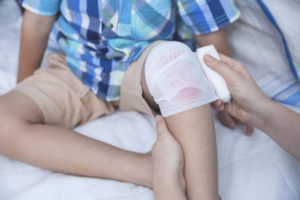Doctors’ Notes
BackCuts & Scrapes
Cuts, scrapes, bumps, and bruises are part of the adventure of being a kid. Although it’s important to try to prevent these injuries, we (unfortunately) can’t prevent them all. Most bumps and bruises require only a kiss and a magic band-aid, but some need more attention.
Here’s a guide for care of those cuts and scrapes, and what to do when it’s a little more than that.
Small Cuts, Scrapes, or Abrasions
• Rinse well with warm water, trying to clean debris out of the area. This is also a good time to assess the area.
• Wash the area with warm water and soap.
 • Pat the area dry and cover with a bandage. Especially if children are continuing their fun adventures in play areas or outdoors, we don’t want to introduce germs into the area. Once it starts to dry out and a scab starts to form, it’s no longer necessary to keep the area covered.
• Pat the area dry and cover with a bandage. Especially if children are continuing their fun adventures in play areas or outdoors, we don’t want to introduce germs into the area. Once it starts to dry out and a scab starts to form, it’s no longer necessary to keep the area covered.
• Observe the healing area for signs of infection: increased redness, warm and tender to the touch, any drainage from the area. If you notice any of these things, give us a call so we can check it out.
Larger Cuts (Lacerations)
• Rinse the area well with warm water. Assess the area; make sure there is no debris in the cut.
• Cover the area with a clean cloth or gauze. (If a first aid kit is available, you may consider using gloves to keep the area clean as possible and prevent the spread of infection)
• Apply pressure to the area for 5 minutes — no peeking! Try to elevate it to slow the bleeding. (Do NOT apply a tourniquet- this can damage the vessels and tissue of the affected area)
• If it’s bleeding enough that it soaks through the gauze or cloth, do not replace it with a new cloth — just add more on top of the existing gauze.
• These larger cuts typically need to be evaluated by a medical provider. The cut may need stitches. There is an increased risk of infection, and damage to the underlying tissues.
When Does a Cut Need Stitches?
• Deep larger cuts, or cuts that are gaping.
• Cuts that take longer than 5 minutes to stop bleeding.
• If the cut is on the face or neck.
• If the area is spurting blood (it may have affected an artery).
• If, after rinsing, the area still has debris stuck in it.
It’s also important to make sure vaccines are up to date, specifically the Tetanus vaccine — especially if the wound occurred from a bite or rusty metal, or if it has been exposed to a lot of dirt. If it’s been over 5 years since your child has received a tetanus shot, he/she should receive a booster.
Call 911 If…
• Any body part is severed
• The cut is severe
and/or
• Bleeding is difficult to control.
And, as always, you can give us a call in the office any time if you have any questions or concerns.
Jonette McClelland, a Certified Registered Nurse Practitioner, joined Kids Plus in 2012.